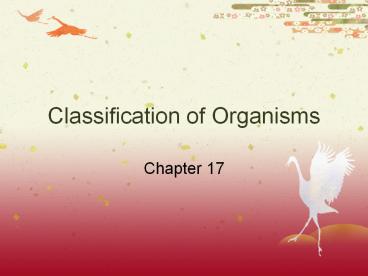Classification of Organisms - PowerPoint PPT Presentation
1 / 14
Title:
Classification of Organisms
Description:
The goal is to classify organisms in terms of their natural relationships Phylogenetics The analysis of the evolutionary or ancestral relationships among taxa. – PowerPoint PPT presentation
Number of Views:122
Avg rating:3.0/5.0
Title: Classification of Organisms
1
Classification of Organisms
- Chapter 17
2
Biodiversity
- The variety of organisms considered at all levels
of populations to ecosystems. - Biologists have classified almost 2 million
species - More remain unidentified
www2.warwick.ac.uk/ about/environment/faqs/
3
Taxonomy
- The science of describing, naming, and
classifying organisms - A particular group within a taxonomic system is
called a taxon
www.schenectady.k12.ny.us/.../ Taxonomy.html
4
Taxonomy continued
- Aristotle classified organisms into 2 groups
plants or animals. - This was inadequate because more and more
organisms are found and described.
5
The Linnaean System
- The system of grouping organisms into
hierarchical categories according to their form
and structure. - Each category represents a level or grouping from
larger, more general categories to smaller, more
specific categories.
6
Levels of Classification
- Modern version of Linnaeuss system uses 8
levels (see page 338) - 1. Domain
- 2. Kingdom
- 3. Phylum
- 4. Class
- 5. Order
- 6. Family
- 7. Genus
- 8. Species
7
Binomial Nomenclature
- System of two-part names. The genus name
followed by the species identifier. - The species name is written in Italics with the
genus name capitalized - Species names generally come from Latin roots
- Subspecies variations of a species that live in
different geographic areas
8
Binomial Nomenclature(examples)
- Homo sapiens
- Chaos chaos
- The species name or scientific name is written in
italics with the genus name capitalized
9
Systematics
- Modern biologists use this to classify organisms
not only by visible similarities, but also
similarities in embryos, chromosomes, proteins,
and DNA. The goal is to classify organisms in
terms of their natural relationships
10
Phylogenetics
- The analysis of the evolutionary or ancestral
relationships among taxa. - Systematists usually use several types of
evidence to hypothesize about polygenetics. - Use phylogenetic diagram
11
Cladistics
- A system of phylogenetic analysis that used
shared and derived characters as the only
criteria for grouping taxa
12
Three Domains of Life
13
Three Domains of Life
Domain Bacteria Domain Archaea Domain Eukarya
Small, single-celled prokaryotic organisms Prokaryotes, live in harsh places, has distinctive cell membranes Eukaryotic organisms, large cells with true nucleus and complex organelles
Ex. Cyanobacteria Hetrotrophic bacteria Ex. Halophiles and Thermophiles Ex. Everything else plants, animals, etc.
14
Six Kingdoms
- Eubacteria
- Arachaebacteria
- Protista
- Fungi
- Plantae
- Animalia
See page 349































